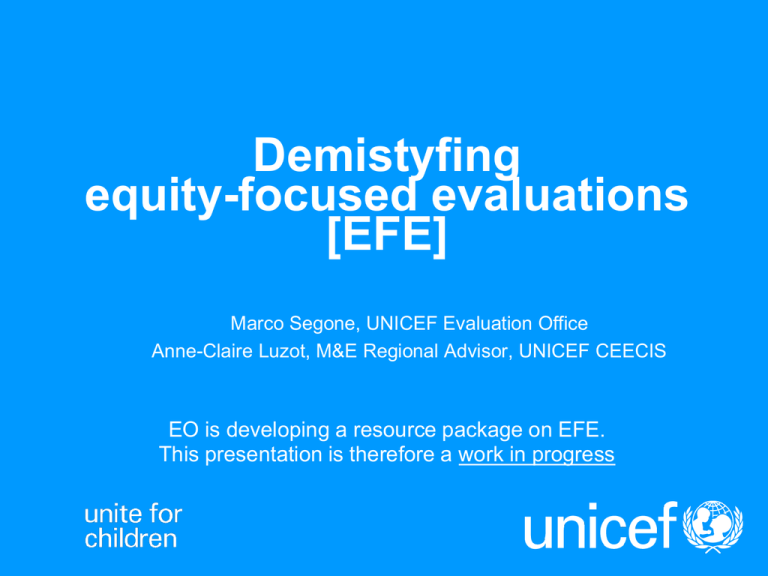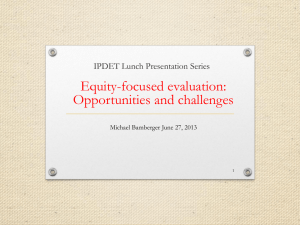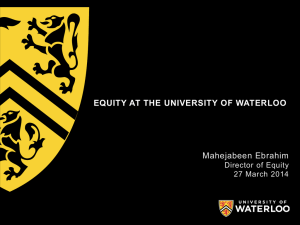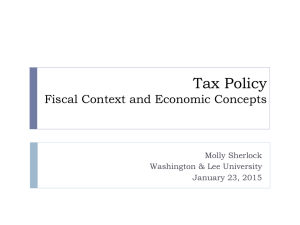What is an equity-focused evaluation?
advertisement

Demistyfing equity-focused evaluations [EFE] Marco Segone, UNICEF Evaluation Office Anne-Claire Luzot, M&E Regional Advisor, UNICEF CEECIS EO is developing a resource package on EFE. This presentation is therefore a work in progress Outline 1. 2. 3. 4. What does Equity mean? Why does Equity matter? What is an equity-focused evaluation? How to manage an Equity-focused evaluation? What does equity means? Defining Equity • Equity means that all children have an opportunity to survive, develop, and reach their full potential, without discrimination, bias or favoritism • The disparities between population groups that are not driven by biology, are avoidable and unfair are termed inequities. • Equity is therefore based on notions of fairness and social justice All rights for all children everywhere, by prioritizing the most deprived Graph 1: % of children (7-14 years old) out of school, by race/ethnicity 2000 Baseline and goals for national average, black and white children 2010 Goal: reduce by 50% the national average and the equity ratio between black and white children Equity Ratio : 1,8 6.9 5.5 Black children National average 3.1 2.8 2.2 2000 2001 2002 2003 2004 2005 2006 2007 2008 2009 2010 1,4 White children Equity ratio: 3.8 Drivers: Income Under-five mortality rate in Central Asian countries, by wealth of households 110 per 1000 Poorest 60% Richest 40% 55 0 Kazakhstan Kyrgyzstan Uzbekistan Tajikistan UNICEF Source: DHS data. From NAGA pg. 27 Drivers: locations Proportion of children aged 0-59 months living in households that do not provide adequate support for early learning and development, by worst-off and best-off regions 60 % Best-off region Worst-off region 40 Eastern Europe UNICEF Tajikistan Kyrgyzstan Uzbekistan Albania BiH Georgia Belarus Serbia Macedonia Montenegro 0 Kazakhstan 20 District level Data - Nyanza Province Central Asia Drivers: education 50 % Proportion of children aged 0-59 months living in households that do not provide adequate support for early learning and development, by level of education of mother/caretaker Basic or less Higher than basic Eastern Europe UNICEF Central Asia Tajikistan Kyrgyzstan Uzbekistan Albania Bosnia and Herzegovina Georgia Belarus Serbia Macedonia Montenegro 0 Kazakhstan 25 Drivers: Gender The majority of out-of-school children continue to be girls (53%); achieving gender parity would mean 3.6 million more girls in primary school Drivers: Disabilities 90% of children with disabilities in developing countries do not attend school Multiple Dimensions: Who is not learning? Disparity in learning How is equity different from or similar to the Human Rights Based Approach and CRC? • UNICEF’s foundation strategy of a human rights based approach underpins the equity agenda. • Equity cannot be effectively pursued outside of a human rights framework, while human rights cannot be realised while inequity persists. • Reaching the marginalized and excluded has always been integral to UNICEF’s work (Progress for Children 2010). We are doing it. But are we doing it sufficiently and everywhere? 12 Why does equity matter? Why equity Equity has a significant positive impact in reducing poverty Poverty is very sensitive to income distribution changes, and small improvements in income distribution can have an important positive effect in reducing poverty. Equity has a positive impact on economic growth Equity and economic growth rates are directly related, with higher equity having a positive impact not only on poverty reduction but also on economic growth itself. Higher equity can therefore benefit the poor in two ways: by increasing the overall growth rate and average income, and by letting them share in that growth, since growth with less inequity benefits the poor more. Why equity Equity has a positive impact in the construction of a socially fair and democratic society Unequal opportunities of social groups in society is often a significant factor behind social unrest, which may lead to crime or even violent conflict, with negative effects for the social cohesion of a society. Prolonged inequity may lead to the “naturalization” of inequity The long “stability” of inequity in several countries makes it something “natural”. When inequity is perceived as a natural phenomenon, society develops theoretical, political and ideological resistances to identify and fight inequity as a priority in public policies. Inequity constitutes a violation of human rights and hampers the equitable achievements on Human Development and MDGs What is an equity-focused evaluation? What is an equity-focused evaluation? A judgment made of the relevance, effectiveness, efficiency, impact and sustainability of interventions on equitable development results. Purposes of equity-focused evaluation Accountability Organizational learning and improvement Evidence-based policy advocacy Contribute to Knowledge Management National Capacity development for equityfocused M&E systems Empowerment of worst-off groups Empowering worst-off groups, including children, through Equity-focused evaluation processes • Involve worst-off groups: – To ensure relevance, effectiveness, ownership of evaluation – Focus on Evaluation process use to empower worst-off groups through the evaluation process – Including children • Understanding the cultural, political economic and social context that influence inequity, including perception of, and attitudes to, equity Why are equity-focused evaluation required? • Because “conventional” evaluations have some potential limitations in evaluating equityfocused interventions: – – going beyond conventional quantitative data to analyze behavioral change, complex social processes and attitudes, and collecting information on difficult-to-reach socially marginalized groups. In addition, conventional evaluation are often weak on process and contextual analysis. Is equity-focused evaluation a completely new approach? No. While some new analytical tools are introduced, most of the EFE data collection and analysis techniques are built on existing approaches The emphasis is on refining and refocusing existing technics – and enhancing national capacities to use those technics HOW to manage Equity-focused evaluations? Key Steps 2. Preparing the ToR of an EFE 1 1. Preparing for the EFE 2 4. Collecting/ analysing evidence 3 3. Designing the evaluation 4 6. Utilizing the evaluation 5 6 5. Findings, conclusion and reccs MANAGE RISKS * MANAGE RISKS * MANAGE RISKS * MANAGE RISKS Key Steps 1 2 3 4 5 6 1. Preparing for the EFE MANAGE RISKS * MANAGE RISKS * MANAGE RISKS * MANAGE RISKS . Preparing for the Equity-focused evaluation • Determining the evaluability of the intervention’s equity dimensions • Identifying evaluation stakeholders, including worst-off • Identifying intended use by intended users • Identifying potential challenges in promoting and implementing Equity-focused evaluations Key Steps 2. Preparing the ToR of an EFE 1 1. Preparing for the EFE 2 3 4 5 6 Preparing the ToR of an EFE • Defining the scope and purpose of the evaluation • Framing evaluation questions focusing on equity • Selecting technically-strong and culturally-sensitive evaluation team • Ensuring appropriate budget Framing evaluation questions focusing on equity DAC criteria adapted for EFE • • • • • Relevance Impact Effectiveness Efficiency Sustainability Key Steps 2. Preparing the ToR of an EFE 1 1. Preparing for the EFE 2 3 3. Designing the evaluation 4 5 6 Designing the evaluation • Selecting the appropriate evaluation framework – Theory of Change – Bottleneck analysis Bottleneck supply and demand framework: factors affecting use of services by vulnerable populations Contextual factors • Economic • Political • Institutional • Legal and administrative • Environmental Supply side factors • Coverage •Budgets and available resources •Culturally acceptable services • Culturally sensitive staff Use of services by vulnerable population Demand side factors • Knowledge, Attitudes and Practice of vulnerable groups • Community ownership factors affecting access • distance • cost of travel and fees • available transport • cultural constraints • time poverty 31 Designing the evaluation • Selecting the appropriate evaluation framework • Selecting the appropriate evaluation design Selecting the appropriate evaluation design and tools Contextual factors • Economic • Political • Institutional • Legal and administrative • Environmental Supply side factors • Coverage •Budgets and available resources •Culturally acceptable services • Culturally sensitive staff Use of services by vulnerable population Mix-Methods Demand side factors • Knowledge, Attitudes and Practice of vulnerable groups • Community ownership factors affecting access • distance • cost of travel and fees • available transport • cultural constraints • time poverty Designing the evaluation • Selecting the appropriate evaluation framework • Selecting the appropriate evaluation design • Selecting the appropriate evaluation methods Key Steps 2. Preparing the ToR of an EFE 1 1. Preparing for the EFE 2 4. Collecting/ analysing evidence 3 4 5 6 3. Designing the evaluation MANAGE RISKS * MANAGE RISKS * MANAGE RISKS * MANAGE RISKS Selecting the appropriate evaluation methods Approaches to be used to evaluate complex equity-focused policies and programmes • Systems approach to evaluation • Unpacking complex policies into components that can more easily be evaluated • Pipeline designs • Policy gap analysis • Using other countries or sectors as the comparison group • Concept mapping • Portfolio analysis Key Steps 2. Preparing the ToR of an EFE 1 1. Preparing for the EFE 2 4. Collecting/ analysing evidence 3 3. Designing the evaluation 4 5 6 5. Findings, conclusion and reccs MANAGE RISKS * MANAGE RISKS * MANAGE RISKS * MANAGE RISKS Key Steps 2. Preparing the ToR of an EFE 1 1. Preparing for the EFE 2 4. Collecting/ analysing evidence 3 3. Designing the evaluation 4 6. Utilizing the evaluation 5 6 5. Findings, conclusion and reccs MANAGE RISKS * MANAGE RISKS * MANAGE RISKS * MANAGE RISKS Utilizing the evaluation • Preparing the evaluation report and alternative forms of reporting • Disseminating the evaluation and preparing a Management Response Do you want more? Visit MyM&E Remember This is NOT what I was expecting!!!!! Whose fault is it? Invest time/energy in designing a good quality ToR with all main intended users, and make sure consultants understand it and are comfortable with it Thank you . Group work • Identifying potential challenges in promoting and implementing Equity-focused evaluations • Identify possible way to address the challenges • What support would you need?






